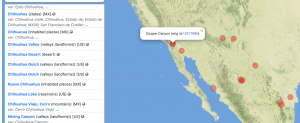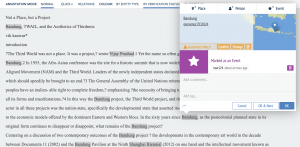Just like others, I was also unsuccessful in uploading the same data to the WHG. Instead, I spent more time looking up places. My first exploration was my hometown in Mexico, Chihuahua, which before my search I associated with both the name of a city and of a state. The variants names for Chihuahua were 35 ( Altepetl Chihuahuah ; Byen Chihuahua ; CUU ; Chihuahua ; Chihuahua City ; Chihuahua by ; Chiuaua ; Chiuauae ; Chivava ; Cihuahua ; Ciuaua ; Dakbayan sa Chihuahua; Tsiouaoua ; chiuaua ; chiwawa ; chyywaywa. chyywaywa ; qi wa wa shi ; zhi hua hua shi ; Čihuahua ; Čiuaua ; Τσιουάουα ; Чивава ; Чиуауæ ; Чиуауа ; Чіуауа ; ציוואווה ; ჩიუაუა ; チワワ ; 奇瓦瓦市 ; 芝華華市 ; 치와와, plus three entries in scripts that my word processor could not reproduce). These are a considerable amount of variants, especially when compared to other more worldwide known places, such as London. The fact that the spelling of Chihuahua is not intuitive might influence in it having these many variants. But they are not too many variants compared to some Chinese cities, as I will show later.
In the WHG, Chihuahua was connected to what I thought it was a well-known geologic formation within the state of Chihuahua, the Copper Canyon. But in the map, this place was located in California, near the border with Mexico. Then I searched for Copper Canyon and results only appeared in the United States. I tried searching using the Spanish names Cañón del Cobre and Barranca(s) del Cobre, and there were no results available.

My second exploration was in China. In my research as an art historian, when trying to follow the itinerary of Latin American artists or intellectuals that traveled to China after WWII, I often find challenging to know exactly where they went. This is because both in published books and manuscripts, the “Spanish” names of Chinese cities are always spelled differently from the contemporary standard names which use pinyin (phonetic transcription). Especially in manuscripts, the authors often write something that sounds like a place, but they might be making up the script.
When searching for the Chinese city that I know better, Hangzhou, the name variants were 69 in total (Chan’nktsoou ; Chang-cou ; Chang-čou ; HGH ; Hancheum ; Hanchow-fu ; Hanczou ; Handzou ; Handžou ; Hang ; Hang Chau ; Hang-chiu-chhi ; Hang-chou ; Hang-chou-shih ; Hang-hsien ; Hangchow ; Hangcsou ; Hangdzou ; Hangdžou ; Hanggouo ; Hangtsjou ; Hangzcouh ; Hangzhou ; Hangzhou Shi ; Hangĝoŭo ; Hančžou ; Hong-chu-su ; Hong-ciu ; Hàng Châu ; Hâng-chiu-chhī ; Hòng-chû-sṳ ; Hòng-ciŭ ; Khanchzhou ; Khandzhou ; Khangdzou ; Khanzhou ; Xanchjou ; hang cow ; hang zhou ; hang zhou shi ; hangacau ; hangajho’u ; hanghtshw ; hangjeou ; hangjeou si ; hangju ; hangzhw ; hanjha ; hannaco ; hʼnggwʼw ; kancu ; Χανγκτσόου ; Хангџоу ; Ханджоу ; Ханжоу ; Ханчжоу ; האנגגואו ; हांगचौ ; हांगझोऊ ; ਹਾਂਙਚੋ ; காங்சூ ; ഹാങ്ഝൗ ; หางโจว ; ཧང་ཀྲོའུ། ; 杭州 ; 杭州市 ; 항저우 ; 항저우 시 ; 항주 plus five entries in scripts that my word processor could not reproduce)
In a way, this makes me feel more relaxed and imagine that I am not the only one dealing with this toponymy issue. I checked other Chinese city and province names (Sichuan, Suzhou, Dalian), and the variants of names included were not as many as for Hangzhou. Why is there so much information about this particular city in the WHG? The collection of variant names of Chinese WHG could be useful in my future research in relation to Chinese names. Just as with any other resource, it makes sense to know what are the strengths of the WHG as a tool for our own research, instead of expecting it to have equal amount and quality of information about all places in the world.
For the annotated text, I tried with a section of the article “Not a Place, but a Project. Bandung, TWAIL, and the Aesthetics of Thirdness” by Vik Kanwar. I am interested in mapping events, which many times take the name from the place where they were first hosted. Like in the case of Bandung, the 1955 Conference and the Indonesian City, the overlap between event and place labels happens often, Versailles and Westphalia were the other two cases in this text. I can imagine that something similar could happen with mapping biennales or other artistic events, such as Art Basel, which happens in Basel, but also in Miami and Hong Kong.

One idea from the readings that stayed with me was how a gazetteer is a collection of triples <N, F, T>, Name, footprint, and type. This is, the basic information required to understand better a place includes what is it called, where it is, and what kind of thing it is (Goodchild, 28-29). Adding the time element makes the definition of a place more complete. I shared this formula with the students of the Intro to Western Architecture course for which I am the TA now, suggesting them to use it when writing about a place, e.g. the Aswan High Dam built in the Nile Valley in the 1960s. I hope this formula helps them and myself to improve our writings.